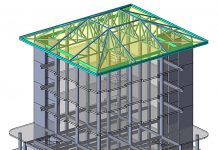Alan Muse, Director of Built Environment Professional Groups at the RICS considers how Level 3 BIM will impact on cost management and the wider construction industry
On construction projects, cost is a function of change. However, the cost implications of change need to be assessed from many stakeholders and inputs and from various project participants. Therefore, BIM, as a collaborative tool, offers great potential to improve cost prediction, assess alternative scenarios, control change and provide the data to solve disputes more pro-actively.
At the moment, quantity surveyors and cost managers are still grappling with Level 2 BIM, but adoption is improving. As with any transformation, there is a wide disparity in take-up. The work of Level 2 has defined new working methods and controls for procuring, validating and processing standard open data. The principles are based on data exchanging, and already people are asking how we can make this faster and more efficient. How can we include geometry and data in the same package, how can we do it on the web across the world?
Early BIM adopters, however, will be aware that the government has recently (see the Government Construction Strategy 2016-20 published in March 2016) re-affirmed its commitment to push forward with BIM implementation at Level 2 and Level 3.
What implications may Level 3 BIM have for quantity surveyors and cost managers? Firstly, however, what is the vision for Level 3 BIM?
The vision for Level 3 is to provide a seamless transition from the achievements of Level 2 in to an environment where technology and working with technology is second nature. The expectation is that progress will be made as more people and organisations find that it is quicker and easier to work this way.
There are a number of organisations already in the market providing parts of these solutions. BuildingSMART, of which RICS are members, has long advocated such an approach with their interoperability strategies, and the time has come for us to find out how we complete the necessary standards not only to enable interoperability in the design and delivery stages of a project, but more importantly, in the operational phase.
We are also seeing new market demands driven from outside the traditional construction sector. The broad IT industry sees construction as a prime candidate to which to sell technology and services which has traditionally been the domain of indigenous tier one providers. How will this play out? Will IT businesses morph into tier one suppliers themselves, and where does the opportunity end?
There are also the concepts of the Smart City and Smart Grid. These approaches seek to use technology to provide better services and environments through the use of technologies and information, but where does that information come from?
The answer of course is the assets and services the construction industry delivers, so conceptually we traditionally look at the world “bottom up” whilst the Smart agenda is looking “top down”. A key to the delivery of this strategy is how we ensure our disparate approaches meet in the middle.
Hence, Project Level 3A will look at how we move from data exchange to interoperability, thus improving transparency and access, with a particular focus on reducing transactions costs.
Level 3B is the integration of as many industry sectors (transport, buildings etc.) as possible across a single open data exchange platform to enable the sharing and Big Data analysis across the sectors. Clearly a challenge for the provision of this scenario is to articulate the benefits to those who we would like to see the data, and the provisions of enabling incentives as well as protection in terms of cyber security and controls.
For cost managers, whole life cost considerations will therefore become more important. Since we now have a standard cost classification for maintenance costs (RICS New Rules of Measurement – NRM 3), cost data for whole life analysis will become more easily available and should improve through Level 3 BIM. Indeed, the government construction strategy recognises this: ‘Early adopter departments will seek to understand the full potential benefits of BIM Level 3, including increased capability for whole-life cost measurements’.
Allied to this, as data develops, carbon counting and environmental performance will become more inextricably linked to design and cost decisions.
Real-time data will enable better and faster information to be available at the project level, but, along with this, there will be an increased need to analyse, distil and present the information so that clients understand the decisions that they are taking.
In addition, standardisation of technical processes becomes increasingly important in order to harness the full power of digital construction. Global standard classifications in specification, space measurement, cost reporting, sustainability measurement and the like will become more important. That is why the RICS are part of global coalitions to develop international standards in property measurement (IPMS) and cost reporting (ICMS). Further details can be found at: http://www.ipmsc.org and http://www.icms-coalition.org
All this data will enable developments in artificial intelligence. This is not utopian. Technology companies, including Google, Facebook, Microsoft and Baidu, are racing to expand their artificial intelligence capabilities. Last year they spent some $8.5 billion on research, deals and hiring (source: Quid). Experts in machine learning are most in demand to work in the field of ‘deep learning’. This is where computers draw insights from large data sets, such as could be used in Smart Cities.
New research from McKinsey (Four fundamentals of workplace automation– November, 2015) shows that technology-driven automation will affect almost every occupation and will change work. However, technology is not poised to replace, but change professional roles. Cost managers in construction can develop new skills and service streams such as whole life and carbon data analysis, better predictive cost and risk tools and managing change in real-time environments – while automating more administrative tasks.
. . . . . . . . . . . . . . . . . . . . . . . . . . . . . . . . . . . . . . . . . . . . . . .
Alan Muse
Director of Built Environment Professional Groups
RICS
Tel: +44 (0)24 7686 8555
contactrics@rics.org
www.rics.org/uk
Twitter @RICSnews













